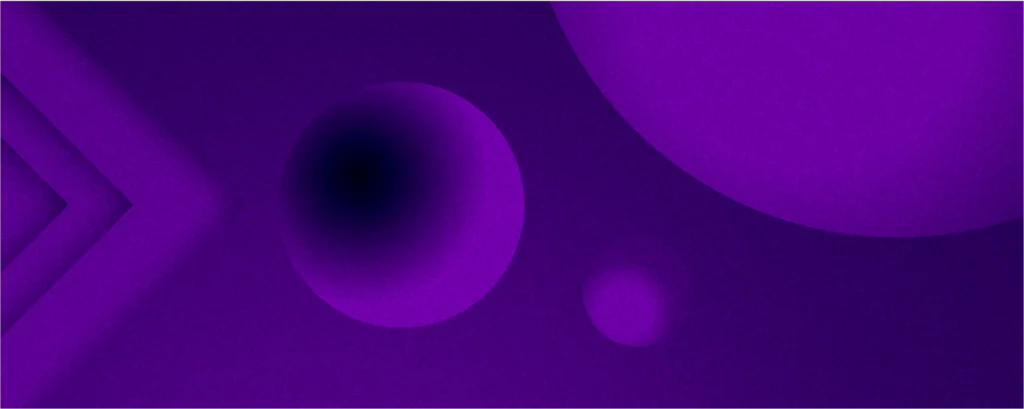May 27th, 2021 | by Szymon Cichoń
Enhanced Product Development - What's Involved and How Much Does It Cost?

Table of contents
Do you think you can transform your groundbreaking idea into a new product by following a straight-line path? Sorry to break it to you: even the most brilliant product concept will not materialize if it isn’t coupled with a smart business model, product-market fit, and solid tech stack that will stand the passage of time.
Building a great software product that users will love is a complex process that requires a systematic approach in which you can’t focus on the front-end only. You should do everything you can to ensure the product fits the already saturated market’s needs because if you won’t build and sustain a user base, your product will fail. Plus, you usually have only one chance to launch, so you’d better do it right, right?
In this article, we talk about what it takes to succeed in the product development process. In particular, we explain:
- What is product development?
- Why should you care about product development?
- What are the stages of product development?
- How do we enhance the process?
- How long does new product development take?
- How much does product development cost?
What is product development?
Product development is the process of bringing a new product into the market. It incorporates everything involved in transforming a new product idea into a ready-to-use (or purchase) product.
This process is fundamental to building useful and successful software products that people will genuinely want to use. An initial idea rarely transforms into the perfect product that fits the market needs and hits the right niche. Luckily, there are tried and tested processes that help you create successful products – read on for details.
Why is the product development process important?
Startup Genome claims only 1 in 12 startups succeed, and Failory identified the lack of product-market fit as the most common reason behind this grim statistic. Although these numbers vary according to different sources (CBInsights indicates a 70% startup failure rate), they prove the stakes are high. Investing in an effective product development process will certainly bring you closer to that exclusive category of “Thriving companies.” In particular, it will help you achieve the following:
- Product-market fit
Contrary to what many people may think, new product development is not just about using the right technology and programming skills to get new products out there. Careful analysis and research of user’s and company’s needs must precede the development work if the product is to succeed on the market. This requires experience, the right expertise, and most importantly, soft skills that will allow you to ask the right questions. If you’re looking to develop a new product with a software development partner, the article about custom software development companies may help you decide how to choose the right one.
- Maximum product usability
Product development is the foundation of creating excellent and functional software products that people will enjoy using regularly. If you don’t question the initial product idea, you may end up with an invalid product that won’t secure its place on the demanding digital product market. Always question the product’s viability, thoroughly research the market and examine the audience in terms of their needs and wants.
- Adequate business model
If you do decide to opt for a software development partner to lead the product development process for you, be prepared to communicate openly with them. Mutual trust, honesty, and willingness to collaborate as closely as possible are necessary to succeed in this process. A good software development partner will be asking a multitude of questions that may undermine the concept behind the product. Still, these are not aimed at discouraging you but rather at ensuring that your innovation and the business model are not only feasible but have been worked out to rock the market.
What are the stages of product development?
What are the phases of this process? The traditional approach includes 6 stages – see the below diagram for a general overview. Keep in mind that this is a universal, simplified description of the product development process. It will vary depending on the market segment, product type, and industry.
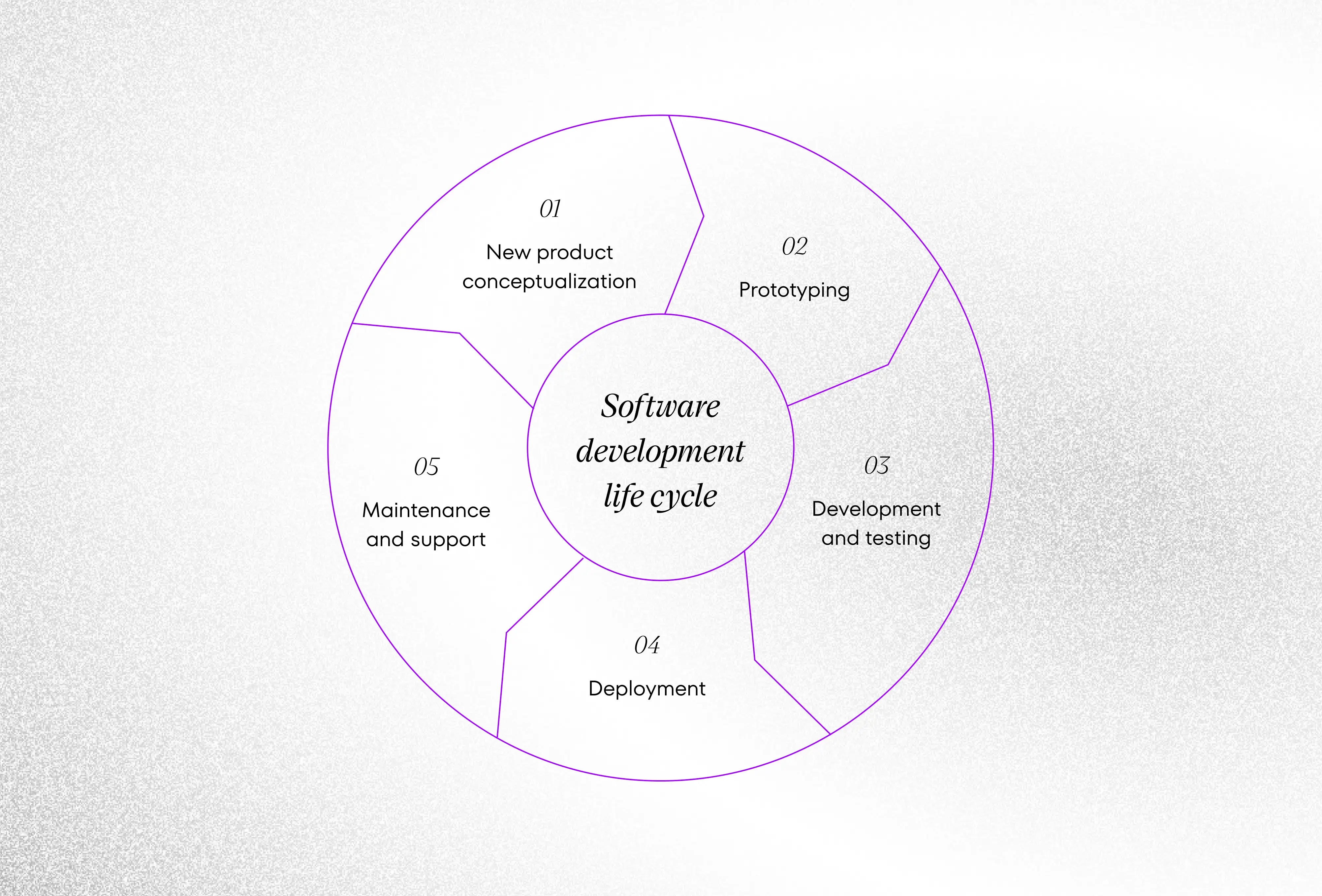
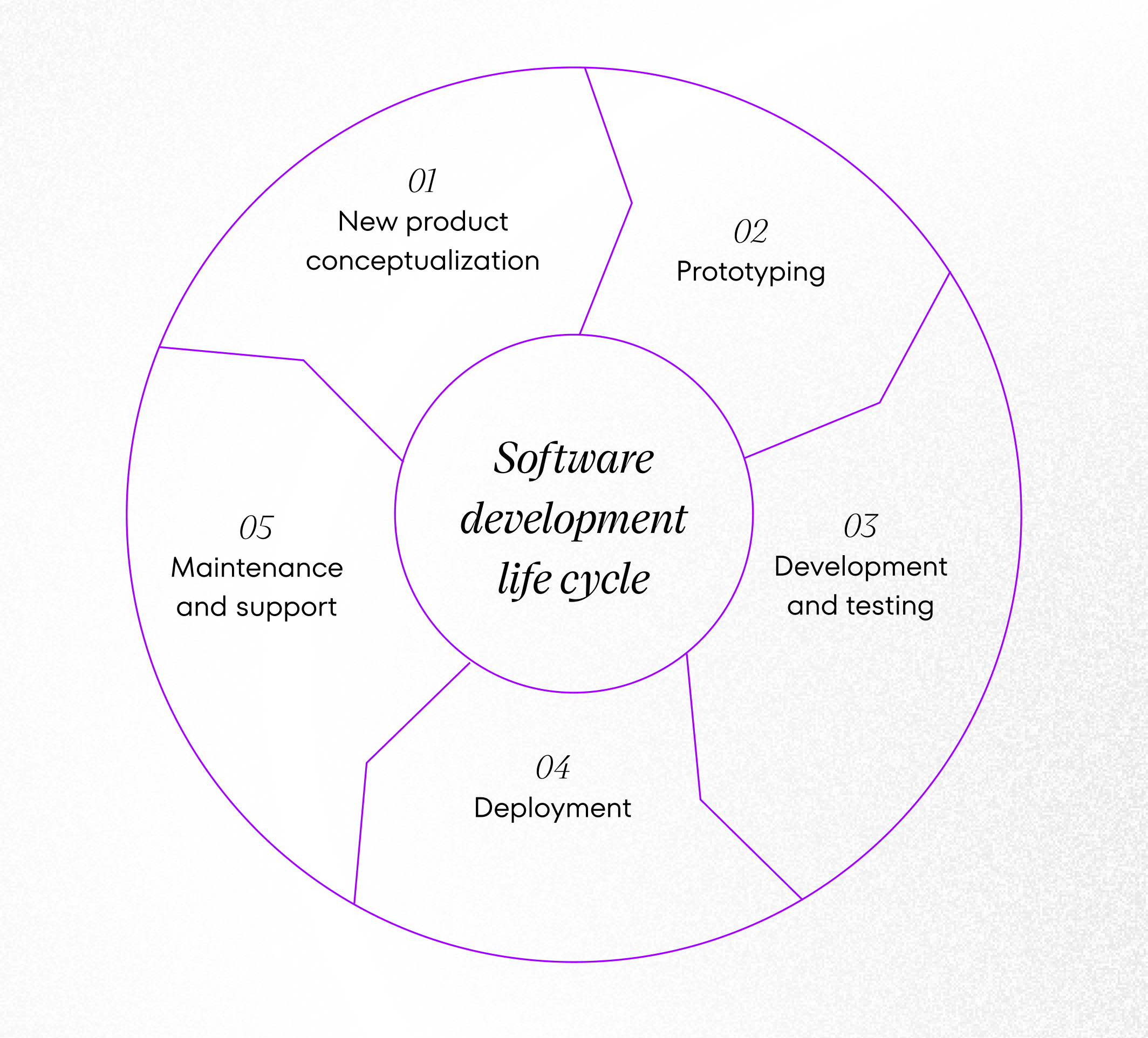
Warning: Undefined array key “caption” in /var/www/cshark/releases/14/web/app/themes/cshark/template-parts/blocks/image-section/image-section.php on line 37
- New product conceptualization
This stage takes you to proof-of-concept through in-depth research of user needs, problems, and competitors. This will always involve some fine-tuning to tailor that idea to market needs and the overall business model. The conceptualization stage allows us to define the new product and envision its place on the market.
- Prototyping
Once the product is conceptualized, product design begins. UI designers will create initial sketches and wireframes to visualize your new tool and its architecture through low- and high-fidelity prototypes. The sketches are then tested for usability and fine-tuned to make sure the product design fulfills customer needs. Creating the prototype will allow you to see what the product will look like and to check whether the front-end design fulfills customer requirements.
Learn more: PoC vs. Prototype vs. MVP – Which One is for You?
- Development and testing
This stage requires a definition of code requirements, planning, coding, testing, and subsequent refinement. To overwork this process, we choose technologies that are the best and quickest to implement for a given solution. The result of this phase is an early version of the product. Agile project management will be the best methodology for this process because it allows you to act quickly and with the flexibility required in the product development process.
- Deployment
This is the big launch phase! It’s about planning the leading to the kick-off date (as well as the kick-off itself) and assigning roles. This stage also involves collecting and analyzing user reviews that will fuel further development iterations. If you want to make your app available on App Store and Google Play, you will have to wait a while for acceptance and be prepared for quick user feedback.
- Maintenance and support
Ensuring the product is up and running at all times will require additional resources and development works. Necessary maintenance activities, such as system and security updates or refactoring the code, are also part of this stage. But that’s just one part of this story; the other is about constantly observing user behavior, competitors, and market trends and making sure we respond to changes as they occur. These activities are mandatory to maintain high user retention rates.
Indeed, the product development process is a development cycle rather than working towards a finished product. In other words: you can never arrive at a final version of the product because market trends and customer needs will constantly evolve, giving room for improvements and tweaks in the existing product. Think about the effect that Clubhouse had on Twitter and Facebook – both had to recognize the need for voice communication and, in consequence, began working on the development of those features on their platforms.
The product development process at CSHARK
When it comes to software product development at CSHARK, we add several elements to the traditional approach that enhance the process and ensure the right start. Let’s take at those elements now:
Product Development Process at CSHARK
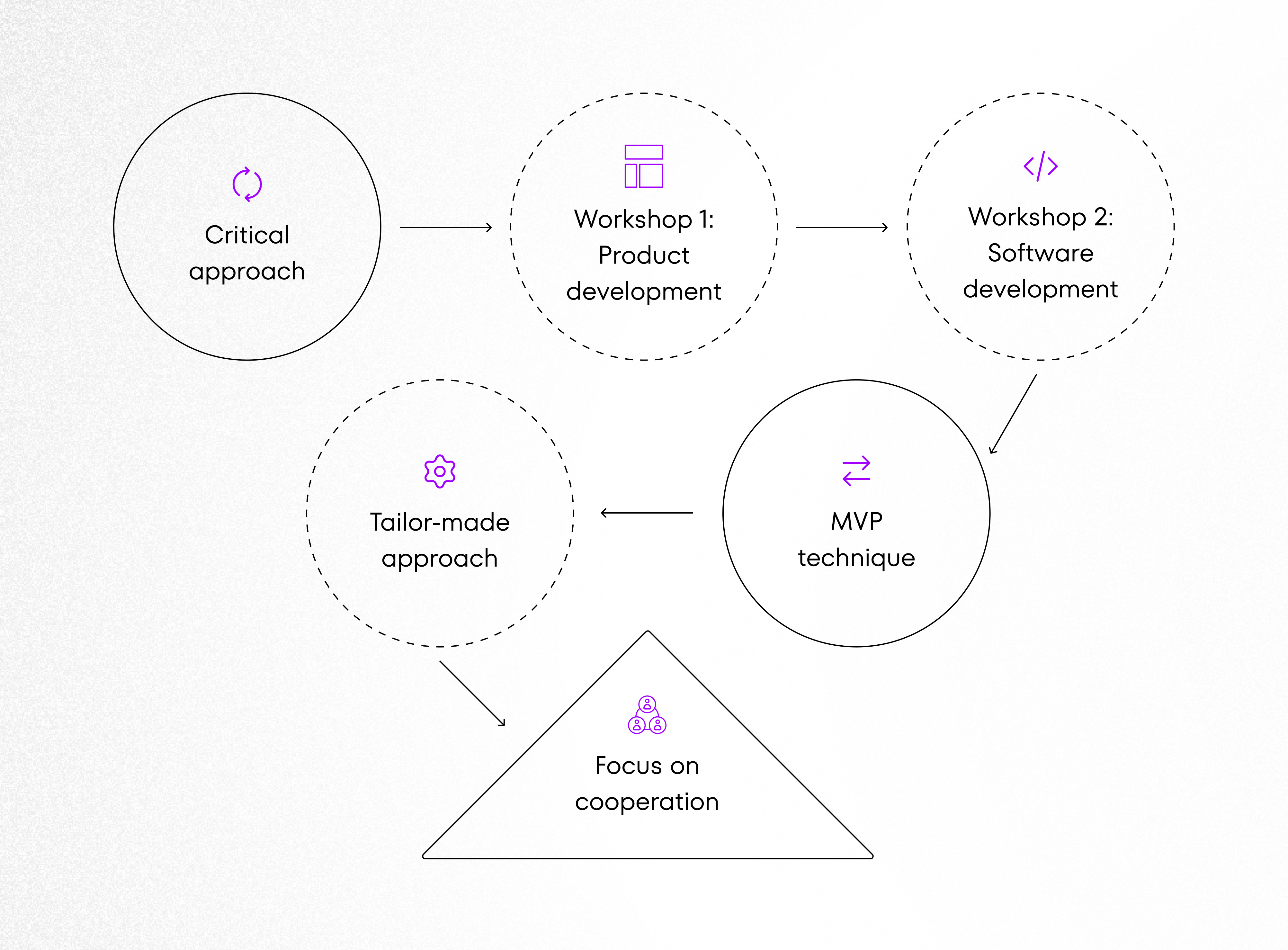

Warning: Undefined array key “caption” in /var/www/cshark/releases/14/web/app/themes/cshark/template-parts/blocks/image-section/image-section.php on line 37
Critical approach
The traditional product development process may not always involve approaching the product idea critically. At the onset, we don’t just look at the product and code itself, as if they were locked in a bubble. We think about whether that bubble has a chance to achieve a product-market fit. That’s why we start by questioning the concept and the business model at the very beginning of the process. Will customers be interested in it? Does it fulfill customer needs and expectations? Will they be willing to pay for it? What is the competition like? It’s crucial to always question the idea, the main assumptions, the users, their needs and test the product repeatedly before the actual release. Without such preparation, the product is likely to fail.
To arrive at a full understanding of how we want to create a product, we bring our clients to the table and run two different sets of workshops with them.
Workshop 1: Product development
This workshop set focuses on examining the idea, clarifying expectations and possibilities, and turning them into a ready-to-market vision of the product. It’s divided into 5 stages and lasts 2 weeks.

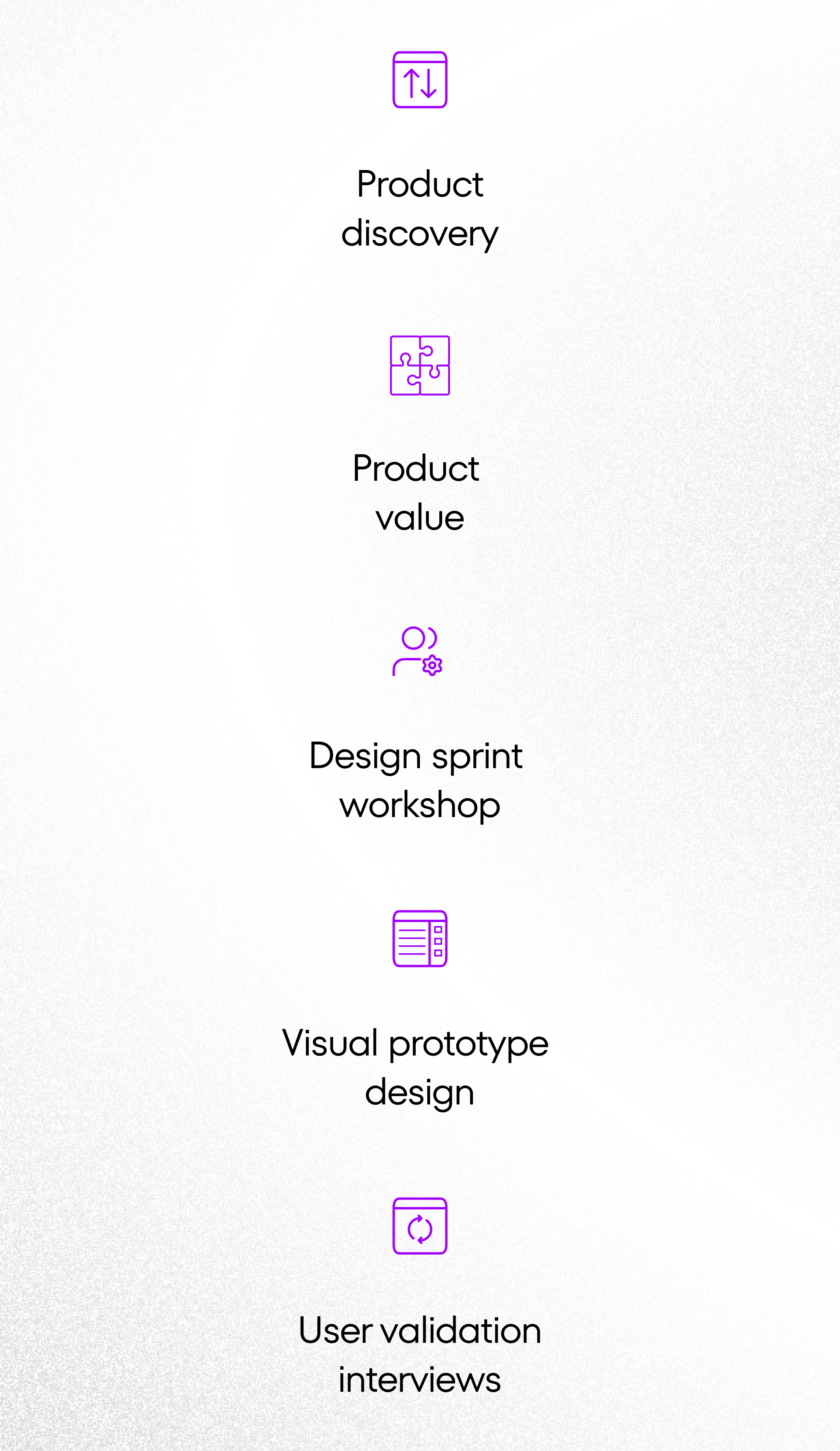
Warning: Undefined array key “caption” in /var/www/cshark/releases/14/web/app/themes/cshark/template-parts/blocks/image-section/image-section.php on line 37
Product discovery
In the early stages, we ask the most important questions about the idea, the potential users, and the industry. These will include: Who are the end-users, and what are their needs? What features can we provide to answer those needs? How important are such features to end-users? Be prepared for an in-depth discussion, which is necessary to make your idea happen and to keep the product on the market. Idea generation and comparison of different product ideas are part of this workshop.
Product value
We translate the needs identified in the first phase into a straightforward value proposition that resonates with the brand during a strategy-oriented workshop. To this end, we create an interdisciplinary team consisting of decision-makers and industry experts from the client-side and our product designers, analysts, architects, software developers, and branding experts. This interdisciplinary team provides diverse perspectives that fuel the discussion on how to market the product and establish its distinctive brand DNA.
Design sprint workshop
This element of the process is about combining the learnings gathered in the previous phases and ensuring that the product’s design satisfies those learnings. The interdisciplinary team discusses How-Might-We and arrives at the best user experience solutions designed specifically for your case.
Visual prototype design
After the Design sprint workshop, we create a low-fidelity, interactive prototype that will visualize the product’s key features and functionalities. The prototype will feature a number of screens, which should be enough for most products.
User validation interviews
Having created a visual prototype, the main goal is to test the initial assumptions. We’ll prepare a user validation interview scenario and gather the first round of feedback to see how far you’re from product-market fit. The scenarios will make up a high-fidelity design, which you can then use in conversations with investors before the app is created.
What are the results of these workshops? Depending on your needs, this set can include:
- User-centered Value Proposition
- Branding essentials: brand values, key competitors, brand vision, and positioning
- The creative brief for keeping a consistent visual style in a .pdf format
- Product mapping
- Lightning demo
- Low-fidelity prototype
With the above deliverables, you are ready to move on to the second phase – making your vision a reality through software development.
ARE YOU INTERESTED IN PRODUCT DESIGN WORKSHOPS? LET US KNOW!
FILL IN THE FORMWorkshop 2: Software development
This second set of workshops is oriented at selecting the right tech solutions in light of the requirements specified during Product development workshops. Here we have four phases.

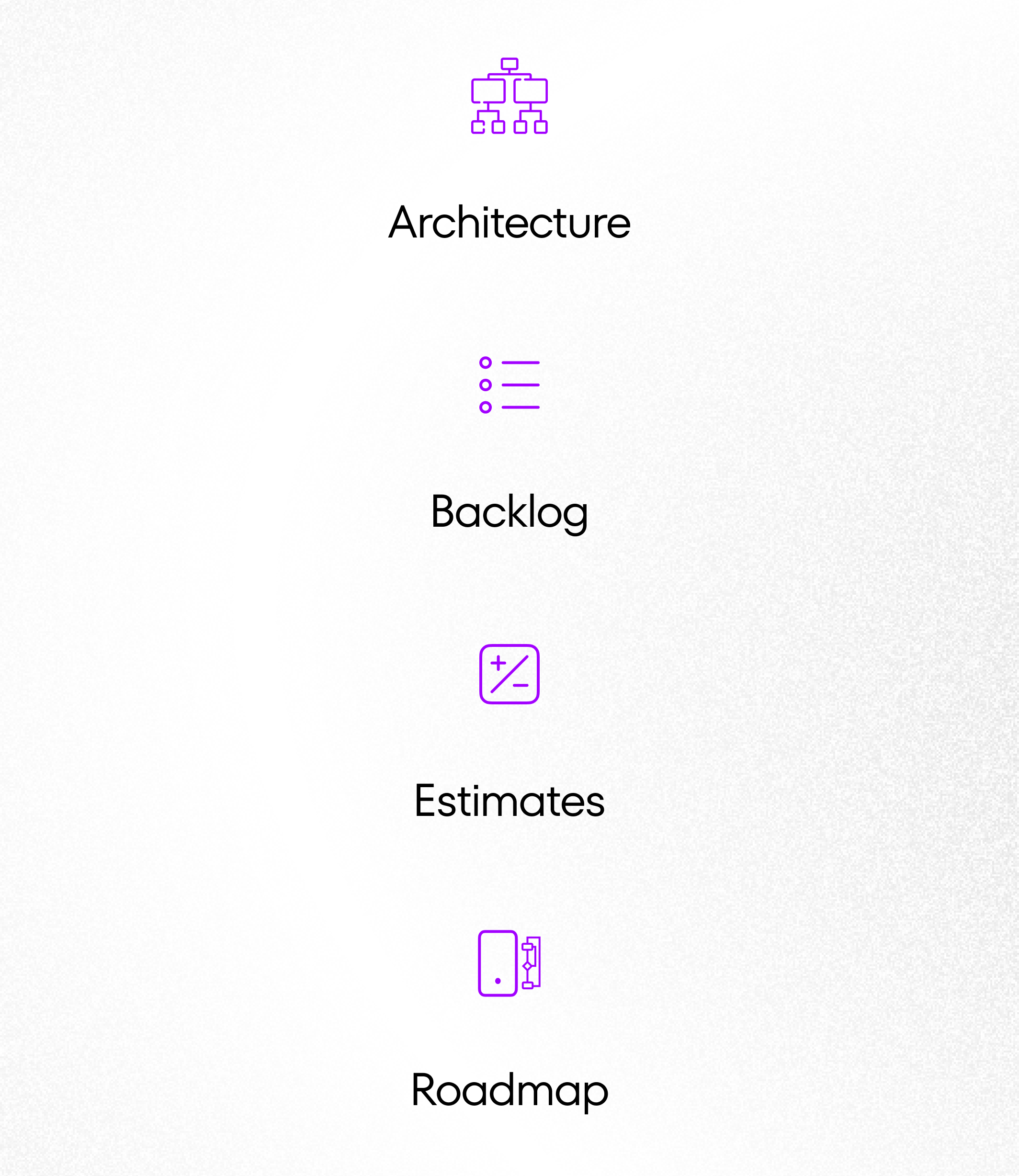
Warning: Undefined array key “caption” in /var/www/cshark/releases/14/web/app/themes/cshark/template-parts/blocks/image-section/image-section.php on line 37
Architecture
Choosing the right stack of tech solutions that will allow you to build your product efficiently and effortlessly is the foundation of building strong architecture. The right architecture also ensures that the product is future-proof and ready for further development or pivots.
Backlog
Backlog is technical documentation of the product that we design jointly with the founder. By carefully planning out user stories and technology assumptions, we’re able to evaluate potential risks and map out the product as a whole.
Estimates
Development is often the most significant financial strain of any digital product development. We will prepare a thorough price estimate which will give you an idea about the cost of individual product functionalities and product management. It will also be a real asset when talking to potential investors.
Roadmap
The roadmap is a result of a strategic workshop in which CSHARK designers and tech leads team up with the product founder. By establishing the way the product will solve certain users’ needs and the precise cost of each functionality, we’re able to lay them out on a roadmap, so that your first release (we focus on MVP development, see the next point for details) is lean and achievable.
Deliverables:
- Architecture diagram
- A comprehensive backlog spreadsheet
- Cost estimates (down to an hour)
- Visual roadmap
MVP technique
The MVP or Minimum Viable Product technique is a relatively new phenomenon that greatly enhances the new product development process. Eric Ries writes all about it in his 2011 book The Lean Startup. This technique focuses on building a simplified version of the product to gather insights about it as early as possible. This early feedback allows you to refine the product’s vision to achieve an even better product/market fit and plan an effective scale-up.
For more details about the MVP approach, check our recent article about MVP software development and how to succeed at creating digital products. In another blog post, you’ll learn about the 15-step process of building an effective MVP.
Tailor-made approach
We tailor the exact scope of the process to the needs of our clients. Sometimes this process will involve a comprehensive business analysis or business modeling; on other occasions, it will involve creating a design system or branding guidelines – it always depends on what’s worth the while based on what has already been created. Most of these things will be determined during initial discovery calls.
Focus on cooperation
The new product development process at CSHARK starts with an initial discovery call with the customer to understand the requirements (thoroughly!) and define the project’s scope. We take part in product development from phase 0; therefore we feel more responsible for the positive outcome. We also pay great attention to establishing preferred communication channels and working closely together from the onset – always adjusting to our client’s needs.
Time and cost of the product development
What is the cost of product development?
At CSHARK, the conversation about price always starts after the scope of the project has been agreed. We prepare user-centric and visually appealing product prototypes, and accurate technology estimates that’ll help you decide if your idea is worth the investment. When all is said and done, two numbers that truly determine how much product development will cost: hours spent and hourly rates.
We usually work with the following pricing models, but we are open to other suggestions as well:
- Fix price: it’s a good option if you’re certain about the project scope and won’t introduce changes;
- Time & Material: the most flexible option that works best when we plan for multiple iterations;
- Target price: we work towards an agreed price. If we work less hours than assumed, the cost of the remainder is split 50:50. If we need to use more hours, you’ll pay only a 50% rate.
The cost of a Minimum Viable Product, which is the result of our two subsequent sets of workshops can range from $40,000 to $120,000, depending on the nature of your product and the scope of the project.
Learn more: MVP Price – How Much Does It Cost to Build an MVP and Why?
How long does it take to develop a new product?
The time required for new product development will depend on the nature of the product and the scope of the development project itself. Both our workshops take about two weeks each, so it’s good to plan at least a month for the process: it involves idea generation, analyzing customers’ needs, engineering, testing, product implementation. Throughout the process, you also think about the product strategy and product management – there is a lot of work involved in bringing innovation to the market and ensuring it secures its position among the competitors. Here’s an orientational timeline:
- Initial discovery call (1 hr)
- Product development workshop (2 weeks)
- Software development workshop (2 weeks)
- Programming (6 months)
- Deployment (2 weeks)
You may start with a great idea, but it is rare that it would perfectly match your target group’s needs. Here at CSHARK, we aim to be a worthy product-to-market partner — one that helps with turning abstract ideas into tangible, investment-ready product innovation. By joining the founder and our expert designers, architects, and analysts forces, we help you materialize the idea. We collect user insights and problems and model a solution that solves them in a realistic way — one that you’ll actually afford to ship.

